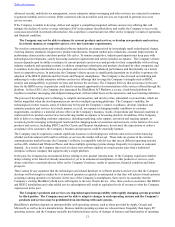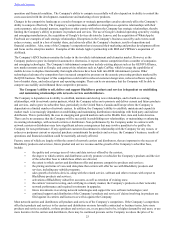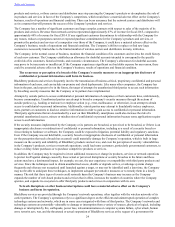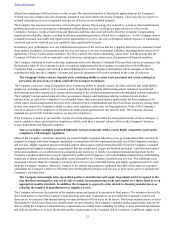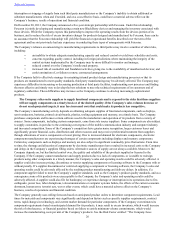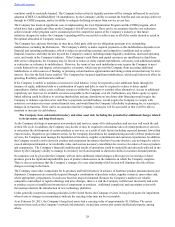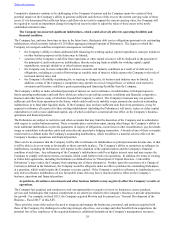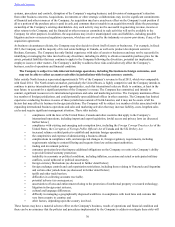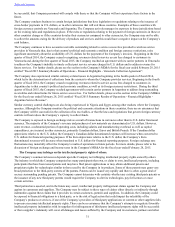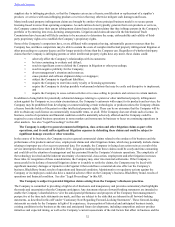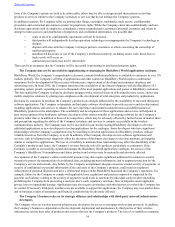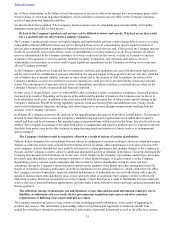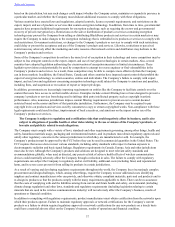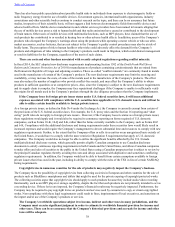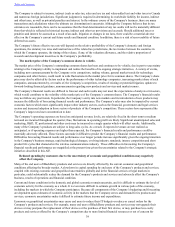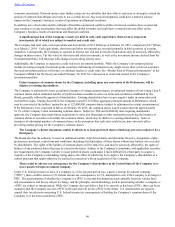Blackberry 2015 Annual Report Download - page 39
Download and view the complete annual report
Please find page 39 of the 2015 Blackberry annual report below. You can navigate through the pages in the report by either clicking on the pages listed below, or by using the keyword search tool below to find specific information within the annual report.
Table of Contents
30
systems, procedures and controls, disruption of the Company’s ongoing business, and diversion of management’s attention
from other business concerns. Acquisitions, investments or other strategic collaborations may involve significant commitments
of financial and other resources of the Company. An acquisition may have an adverse effect on the Company’s cash position if
all or a portion of the purchase price is paid in cash, and common shares issuable in an acquisition would dilute the percentage
ownership of the Company’s existing shareholders. Any such activity may not be successful in generating revenue, income or
other returns to the Company, and the financial or other resources committed to such activities will not be available to the
Company for other purposes. In addition, the acquisitions may involve unanticipated costs and liabilities, including possible
litigation and new or increased regulatory exposure, which are not covered by the indemnity or escrow provisions, if any, of the
acquisition agreement.
As business circumstances dictate, the Company may also decide to divest itself of assets or businesses. For example, in fiscal
2015, the Company sold the majority of its real estate holdings in Canada, as well as its product development center in
Bochum, Germany. The Company has only limited experience with sales of assets or businesses and may not be successful in
identifying or managing the risks involved in any divestiture, including its ability to obtain a reasonable purchase price for the
assets, potential liabilities that may continue to apply to the Company following the divestiture, potential tax implications,
employee issues or other matters. The Company’s inability to address these risks could adversely affect the Company’s
business, results of operations and financial condition.
The Company is subject to risks inherent in foreign operations, including fluctuations in foreign currencies, and
may not be able to collect accounts receivables in jurisdictions with foreign currency controls.
Sales outside North America represented approximately 70% of the Company’s revenue in fiscal 2015, which was comparable
with fiscal 2014. The North American market, particularly the United States, is highly competitive and the Company intends to
continue to pursue international market growth opportunities, such that international sales are likely to continue, at least in the
near future, to account for a significant portion of the Company’s revenue. The Company has committed, and intends to
commit, significant resources to its international operations and sales and marketing activities. The Company maintains offices
in a number of foreign jurisdictions, and could potentially open additional offices in other countries. The Company has limited
experience conducting business in some of these jurisdictions outside of North America, and it may not be aware of all the
factors that may affect its business in foreign jurisdictions. The Company will be subject to a number of risks associated with its
expanding international business operations and sales and marketing activities that may increase liability, costs, lengthen sales
cycles and require significant management attention. These risks include:
• compliance with the laws of the United States, Canada and other countries that apply to the Company’s
international operations, including import and export legislation, lawful access and privacy laws (as discussed
further below);
• compliance with existing and emerging anti-corruption laws, including the Foreign Corrupt Practices Act of the
United States, the Corruption of Foreign Public Officials Act of Canada and the UK Bribery Act;
• increased reliance on third parties to establish and maintain foreign operations;
• the complexities and expense of administering a business abroad;
• complications in compliance with, and unexpected changes in, foreign regulatory requirements, including
requirements relating to content filtering and requests from law enforcement authorities;
• trading and investment policies;
• consumer protection laws that impose additional obligations on the Company or restrict the Company’s ability
to provide limited warranty protection;
• instability in economic or political conditions, including inflation, recession and actual or anticipated military
conflicts, social upheaval or political uncertainty;
• foreign currency fluctuations (as discussed in further detail below);
• foreign exchange controls and cash repatriation restrictions, including those relating to Venezuela and Argentina
and certain other jurisdictions (as discussed in further detail below);
• tariffs and other trade barriers;
• difficulties in collecting accounts receivable;
• potential adverse tax consequences;
• uncertainties of laws and enforcement relating to the protection of intellectual property or secured technology;
• litigation in foreign court systems;
• cultural and language differences;
• difficulty in managing a geographically dispersed workforce in compliance with local laws and customs that
vary from country to country; and
• other factors, depending upon the country involved.
These factors may have a material adverse effect on the Company's business, results of operations and financial condition and
there can be no assurance that the policies and procedures implemented by the Company to address or mitigate these risks will



